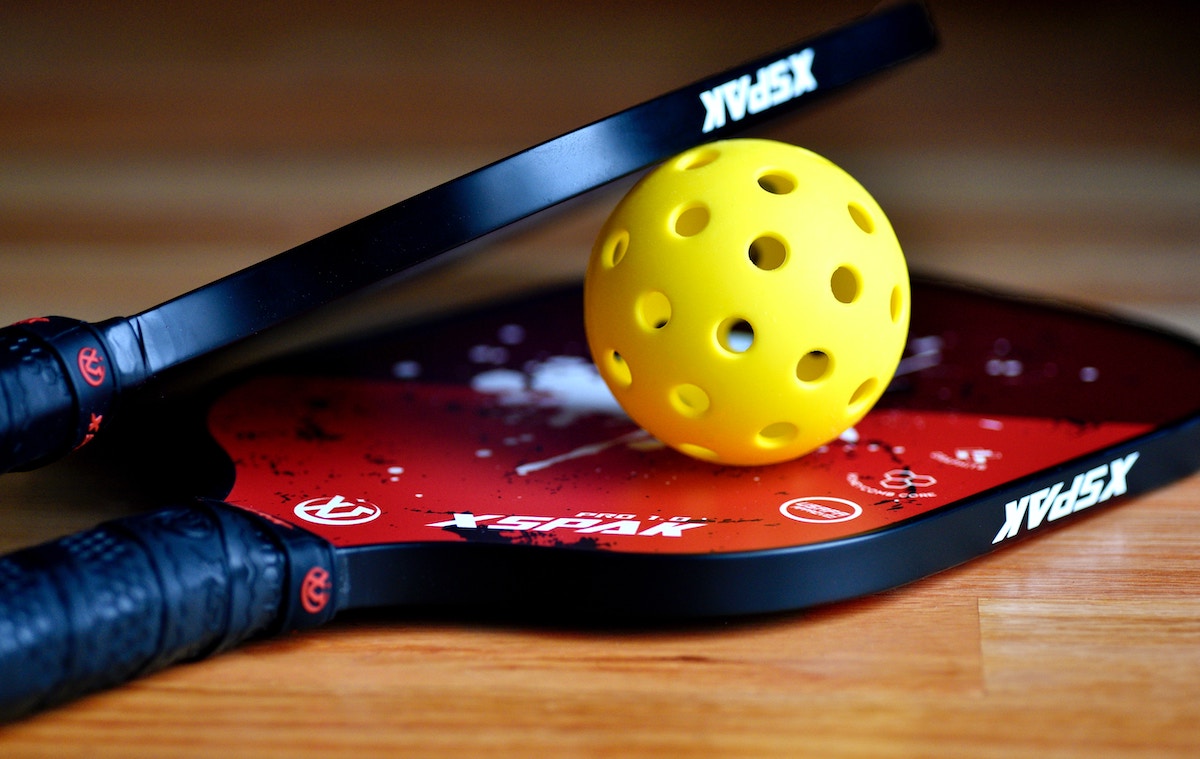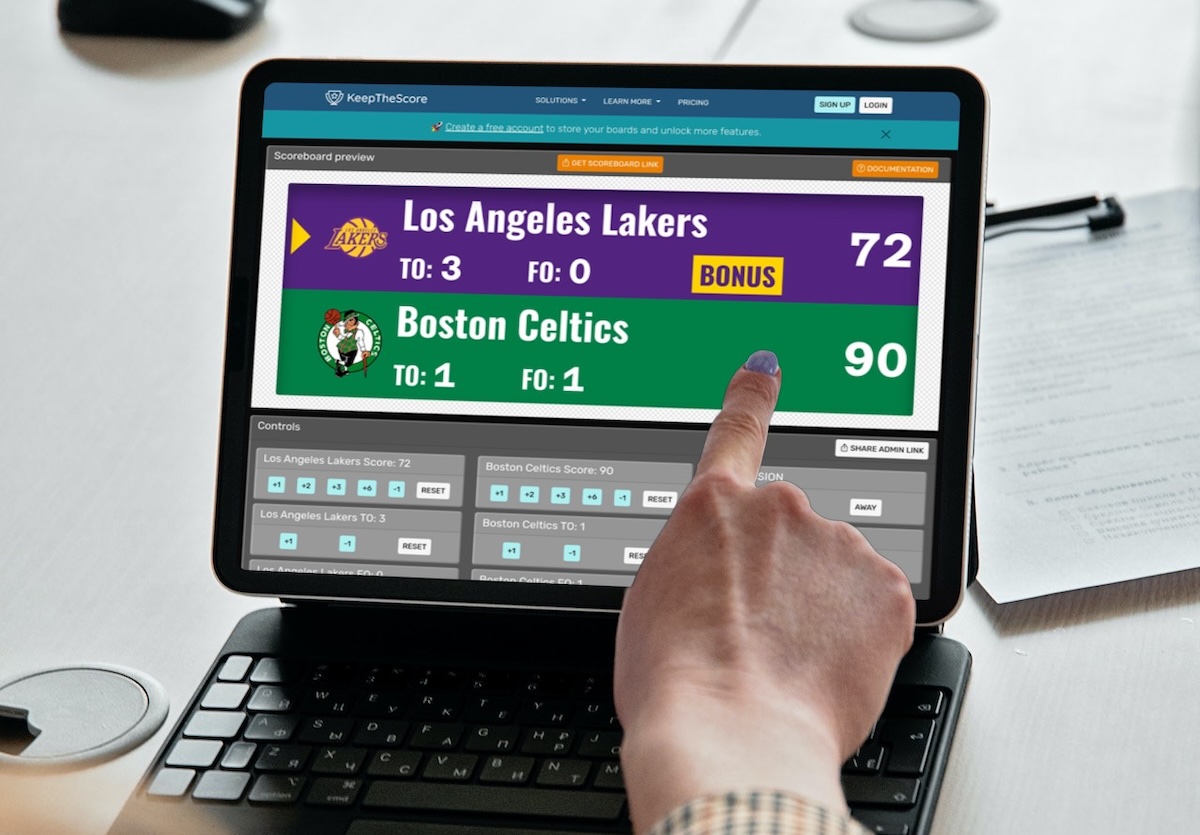
The main objective of pickleball is to outscore your opponent by hitting the ball over the net and landing it within their court. Unlike other outdoor racquet sports, only the serving team can score points.
Pickleball Basics
What equipment do I require?
Before hitting the court, make sure you have the essentials:
- Paddle: The paddles are solid-faced (no strings) and smaller than tennis racquets but larger than ping-pong paddles. Official paddles must not exceed 24 inches in combined length and width, with a maximum length of 17 inches. Choose from wood, graphite, or composite materials to suit your playing style.
- Ball: A hard plastic perforated ball, similar to a wiffle ball, about 3 inches in diameter. Indoor balls typically have 26 larger holes, while outdoor balls have 40 smaller holes for better wind resistance.
- Net: The net is set at 36 inches high at the sidelines and 34 inches at the center, spanning the court width.
On what court is pickleball played?

Pickleball courts measure 44 feet long by 20 feet wide - the same dimensions for both singles and doubles play. The net splits the court in half, and each half is further divided into zones:
- Service Area: The areas on either side of the centerline, behind the non-volley zone, where serves must land.
- Non-Volley Zone (The Kitchen): This 7-foot area on either side of the net where volleying (hitting the ball in mid-air) is prohibited. Players can enter this zone to play a ball that has bounced.
Pickleball courts can be found almost anywhere! Be sure to scout out your neighborhoods for converted tennis courts, and dedicated indoor facilities, or you can even create your own backyard court.
How to Serve
Like tennis, pickleball uses a serving-based scoring system, though with some key differences.
Basic Serving Rules: * Serves must be made underhand with an upward arc * The paddle must contact the ball below the waist (at or below the navel) * Both feet must be behind the baseline when serving - neither foot can touch or cross the line * Serves are made diagonally cross-court into the opposite service box * The serve must clear the non-volley zone - landing on the NVZ line is a fault * You get only one serve attempt (no second serves like tennis)
Drop Serve Option (as of 2021): Players may now use a "drop serve" - dropping the ball (without tossing) and hitting it after it bounces. This removes the underhand restrictions and is often easier for beginners.
Important Rule Change: As of 2021, there are no service lets. If a serve hits the net and lands in the correct service box, it's live and must be played. If it hits the net and lands out or in the kitchen, it's a fault.
When playing doubles, each teammate gets a chance to serve. Here's the standard rotation:
- Player 1 Starts: The player on the right side serves first.
- After a Point: After the serving team wins a point, both players switch sides.
- Loss of Serve: When the serving team loses a point (due to a fault or the opponent returning the serve), the other team gets the serve, and their serving player starts from the right side.
How To Score Pickleball

Pickleball uses side-out scoring - only the serving team can score points.
Key Scoring Rules: * Points are only scored by the serving team * If the receiving team wins the rally, they gain the serve (called a "side out") but don't score * Games are typically played to 11 points (win by 2) * Tournament games may be played to 15 or 21 points (still win by 2) * The game continues past 11 if needed until one team wins by 2 points
The Two-Bounce Rule: A crucial rule for beginners: After the serve, the ball must bounce once on each side before volleys are allowed: 1. The serve must bounce in the receiver's court 2. The return of serve must bounce in the serving team's court 3. After these two bounces, the ball can be volleyed or played off the bounce
Pickleball Scoring (Doubles)
Doubles pickleball has unique scoring rules that can seem complex at first.
How to Call The Score
Before each serve, the server must announce the score using three numbers:
- Serving Team's Score: Your team's current points
- Receiving Team's Score: The opponents' points
- Server Number: Either 1 or 2, indicating which partner is serving
For example: "7-3-1" means the serving team has 7 points, receivers have 3, and it's the first server.
Starting Score Exception: To balance the advantage of serving first, the game begins at "0-0-2". This means only one player from the starting team serves before a side out occurs. This prevents the first-serving team from having an unfair advantage.

Faults / Fouls
In doubles, any action that violates the rules can result in a fault. If a fault occurs by the serving team, they lose the serve and the opposing team gains the opportunity to score. Here are some common faults to be aware of:
- Serving Faults:
- Serving from the wrong location (outside the designated service area).
- Not hitting the serve diagonally into the opponent's service box.
- Failing to serve underhand (with the paddle below the wrist at contact).
- General Fouls:
- Hitting the ball out of bounds.
- Volleying in the non-volley zone (kitchen area).
- Carrying or catching the ball on the paddle.
- Double-hitting the ball (hitting it twice consecutively by the same player).
Server Number and Rotation
The server number (1 or 2) changes based on position, not player:
- First Server: Whoever is on the right side when their team gains the serve becomes Server 1
- Switching Sides: When the serving team scores, both partners switch sides and the same server continues
- Second Server: When Server 1 loses the rally, their partner (Server 2) serves from their current position
- Side Out: When Server 2 loses the rally, it's a side out - the other team gets the serve
Important: The "Server 1" designation isn't permanent - it's determined by who's on the right when the team regains serve.
Remember, understanding these core aspects of pickleball scoring in doubles will allow you to keep track of the game effectively.
Pickleball Scoring (Singles)
Singles scoring is simpler with only two numbers called: server's score first, then receiver's score.
Serving Position Rule: * Serve from the right side when your score is even (0, 2, 4, etc.) * Serve from the left side when your score is odd (1, 3, 5, etc.) * When you score, you switch sides and serve again * When you lose the rally, it's an immediate side out (no second server)
Common Faults
A fault results in loss of serve or point. Here are the most common:
Service Faults: * Foot fault - stepping on or over the baseline before hitting the ball * Serving into the net, out of bounds, or into the non-volley zone * Landing on the NVZ line (other lines are legal) * Not serving underhand (for traditional serves)
Non-Volley Zone (Kitchen) Faults: * Volleying while standing in or touching the NVZ line * Momentum carrying you into the NVZ after a volley * Note: You CAN enter the kitchen to play a ball that has bounced
General Faults: * Hitting the ball out of bounds * Ball bouncing twice on your side * Touching the net or crossing onto opponent's side * Violating the two-bounce rule (volleying the serve or return of serve)
By understanding these common faults, you can avoid giving away points and keep the game flowing smoothly. Remember, if you're unsure about a specific action being a fault, it's always best to clarify with your opponent or consult the official rules.
What is Shown in a Pickleball Scoreboard?
Pickleball scoreboards typically display:
- Team Scores: The two point totals (server number is announced verbally, not displayed)
- Team Names/Logos: Identifying each team
- Serve Indicator: Shows which team is currently serving
- Game/Set Score: In tournament play
Key Terms: * Side Out: When the serving team loses their serve after both partners have served (except at game start) * Rally: The continuous play from serve until a fault * Dink: A soft shot that lands in the opponent's kitchen
With a little practice, understanding pickleball scoring becomes second nature. Remember, only the serving team scores, points go to 11 with a two-point lead, and different rules apply for singles versus doubles.
Quick Reference Guide
Doubles Scoring: - Call three numbers: serving score - receiving score - server number - Game starts at 0-0-2 (only one serve) - Whoever is on the right when team gains serve is Server 1 - Only serving team can score
Singles Scoring: - Call two numbers: server score - receiver score - Serve from right when score is even, left when odd - Immediate side out when server loses rally
Remember: - Games to 11, win by 2 - No service lets - play the ball if it lands in - Two-bounce rule applies to every rally - You can enter the kitchen for bounced balls
Create Your Own Pickleball Scoreboard
KeepTheScore is one of the leading solutions for creating Pickleball scoreboards.

Our pickleball scoreboards include specialized features:
- Automatic Win-by-2 Logic: Games continue past 11 until a 2-point margin is achieved
- Configurable Points to Win: Choose 11, 15, or 21 points per game
- Smart Serve Tracking: Automatic side-out detection with first serve indicators
- Set Management: Best of 1, 3, or 5 sets with automatic progression
- Set Winner Indicators: Visual markers for completed sets
- Remote Control: Update scores from any device - perfect for referees
- Live Streaming: Add professional scoreboard overlays to your broadcasts
- Team Customization: Add names, logos, and colors
We pride ourselves on being very easy to get started with.
Sources
- USA Pickleball Official Rules - Court dimensions, equipment specifications, and current scoring rules
- USA Pickleball 2024 Rulebook - Complete rules including drop serve and no-let serve updates
- Pickleball Central Rules Guide - Serving rules and scoring examples
- PPA Tour Rules - Professional play standards and interpretations
Last updated: January 2025 to reflect current USA Pickleball rules








